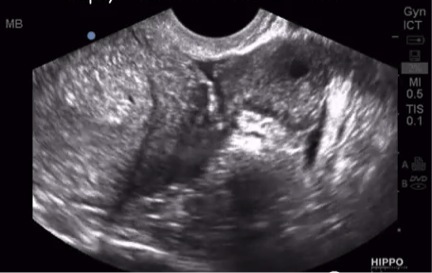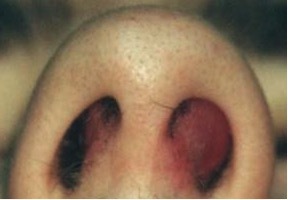Deferoxamine
Iron
A 54 year old patient from a stroke rehab center is brought to the ED because he became lethargic after three days of chest pain, fever, chills, and productive cough with streaking blood. Vital signs are blood pressure 88/43, heart rate 134 BPM, respiratory rate 26/min, oxygen saturation 96%, and temperature 102.2F (39C). Physical exam reveals an ill appearing male with dysarthria and left sided weakness. Chest radiograph shows a right middle lobe cavitary lesion with an air fluid level. What is the most likely infective organism?
Polymicrobial from aspiration
A 22-year old pregnant female at 24 weeks gestation presents to the Emergency Department with a severe headache that developed gradually over 24 hours. She denies fever, other infectious symptoms, or trauma. Vital signs: BP 165/91, HR 85, RR 18, T 98.7F (37.0C). During the physical exam, the patient has a 30 second generalized tonic-clonic seizure that resolves without medication. In addition to consulting obstetrics, which of the following is the most appropriate next step in management?
IV Magnesium
An 18-year-old male patient presents with sore throat, tonsillar exudates, and cough. He is afebrile and without anterior cervical lymphadenopathy. What is the patient’s Centor criteria score and would you treat with antibiotics?
Centor score=1. Do not treat
Centor criteria are as follows (each 1 point, for a total of 4 points): Temp >100.4F (38.0C); Absence of cough; Anterior cervical lymphadenopathy; Tonsillar exudates.
The modified Centor criteria factor in age: Age <15 years adds one point; Age >44 years subtracts one point.
0-1 points: no antibiotic or throat culture needed (risk of strep infection <10%)
2-3 points: obtain throat culture and treat if culture positive (risk of strep infection 15% for 2 points, 32% for 3 points)
4-5 points: empirically administer antibiotics (risk of strep infection 56%).
In adults, presence of all 4 original criteria = 40-60% positive predictive value, while absence of all 4 original criteria = 80% negative predictive value.
A 6-year old girl is rescued by a lifeguard after being found struggling at the bottom of a pool for an unknown period of time. She presents to the ED awake and alert. Her pulse oxymetry is 98% on room air and her temperature is 95.5 degrees F (35.3 degrees C). She has a pronounced cough and is shivering. The disposition of this patient involves:
Discharge after 4-6 hours of observation and normal CXR
Acetaminophen
N-Acetylcysteine
A 3-month-old ex-35-week premature infant presents to the emergency department with 1 day of cough, rhinorrhea, and increased work of breathing. Wheezing and subcostal retractions are observed on exam, but the patient does not exhibit cyanosis. Oxygen saturation is 92% on room air. Viral PCR is positive for respiratory syncytial virus. Which intervention is most efficacious in treating this disease process?
Suctioning
A 27-year old female presents to the Emergency Department with severe abdominal pain for the previous two days. Her urine pregnancy test at triage is positive. Vital signs on presentation are: blood pressure 85/60, heart rate 115 bpm, and respiratory rate 16. She is afebrile. Physical exam is significant for abdominal pain with guarding but no rebound. Pelvic exam is unremarkable. Bedside ultrasound is shown below. Which of the following is the most appropriate next step in management?

2 large bore IVs, Type and Screen, OB consult. Adnexal mass on US
A 55-year-old male presents to the Emergency Department with right sided facial pain. He reports he was struck in the face during a bar fight the night before. He reports significant pain as well as numbness over his cheek. Physical exam reveals ecchymosis to the right face as well as diminished sensation to the right cheek. Which of the following is most likely to be injured?
Maxilla fracture. Maxillary branch of trigeminal nerve
A 30-year-old female presents to an urgent care for swelling and cramping of her left hand. She reports putting on a pair of gardening gloves when she suddenly felt pain in her hand and possibly saw a spider fall out of the glove. On exam she is in moderate distress secondary to pain. Skin examination reveals a central punctum with some mild surrounding errythema. The patient complains of significant muscle spasm and weakness. What is the mechanism of action of the toxin found in this spider’s venom?
Neurotoxin causing muscle weakness from black widow
Methanol
Fomepizole
A 3-year-old male is brought in by his parents for severe coughing and shortness of breath. The mother reports that the child was playing in the living room alone about 30 minutes before when she suddenly heard him coughing severely. Chest x-ray shows a hyperinflated right lung but no infiltrates or pneumothorax. What is the most appropriate next step in management?
Bronchoscopy
A 24-year-old female presents at 32 weeks gestation with diffuse abdominal pain, tremor, and nausea and vomiting. Her BP is 108/64, and the rest of her vital signs are normal. Exam reveals diffuse abdominal pain and jaundice. Laboratory evaluation reveals hypoglycemia, hypofibrinogenemia, and elevated bilirubin, and bedside ultrasound shows ascites. What is the diagnosis?
Acute fatty liver of pregnancy
Acute fatty liver of pregnancy or AFLP, occurs in 1 in 10,000 pregnancies and presents nearly always late in pregnancy. Fat vesicles accumulate within hepatocytes to the point the liver is unable to function. Unrelenting nausea and vomiting are common complaints, but some women may have confounding signs of preeclampsia such as hypertension, proteinuria, and edema. Laboratory findings may be helpful in differentiating the AFLP and preeclampsia. For example, in comparing the laboratory results of different studies, AFLP is more likely to have elevated bilirubin (mean of 11 mg/dl in AFLP vs 1.5 mg/dl in HELLP), hypofibrinogenemia (mean of 105 mg/dl and 136 mg/dl in AFLP vs 480 mg/dl in HELLP), hypoglycemia, and ascites (30% of patients in AFLP vs 6.6% and 8% HELLP)
 A 25-year-old male presents to the emergency department after a bar fight. He reports he was struck in the nose with a closed fist. Physical exam is shown. Which of the following is the most appropriate next step in management?
A 25-year-old male presents to the emergency department after a bar fight. He reports he was struck in the nose with a closed fist. Physical exam is shown. Which of the following is the most appropriate next step in management?
I&D
A patient in Eastern Texas comes to the ED after noticing a red circular area on his arm that started several days ago after clearing out an old shed behind his house. Today he woke up with the area ulcerating and becoming more painful. He doesn’t recall a bite or sting or any pain prior to the ulceration. At this time what is proper treatment for this envenomation and what is source?
Supportive care and Tetanus. Brown recluse bite
Lithium
Dialysis
A 70-year-old female patient is brought in by family members to the emergency department for shortness of breath. She describes acute onset of shortness of breath and pleuritic chest pain that started approximately 6 hours previously. Past medical history is significant for colon cancer, diabetes, and chronic renal insufficiency. Vital signs are BP 120/60 HR 110 RR 30 O2sat 92% on RA. On exam she is tachypneic but speaking full sentences. Lung sounds are clear to auscultation bilaterally. Laboratory testing reveals a creatinine of 4.8 mg/dl (424.32 µmol/L). Which of the following is the most appropriate diagnostic test for this patient?
V/Q scan
A 32-year old female with a past medical history of diabetes and hypertension presents to the emergency department with lower abdominal pain for the last several hours. She describes the pain as gradually progressing throughout the morning. Vitals signs on presentation are: BP 110/70 HR 96 RR 14 T 98.6 F (37C). Physical exam reveals diffuse abdominal pain with guarding. Laboratory testing is significant for a beta HCG of 5,200 mIU/mL. Pelvic ultrasound reveals free fluid in the abdomen. What is the most likely location of this patient's pregnancy?
Ampulla of fallopian tube
80% occur here
A 45-year-old male with no past medical history presents to the ER with sudden onset facial swelling. He has never had this before but he reports his father has had similar problems in the past. Vital signs are: HR 110, RR 22, O2 sat 96%, and temperature 98.6F (37C). Physical exam reveals significant swelling of the lower lip but is otherwise unremarkable. Which of the following is the best treatment of this patient's condition?
Ictibant
Hereditary angioedema
A 56-year old male presents in cardiac arrest. Per witnesses, the patient enjoys ice swimming and dove into a partially frozen lake and never resurfaced. He was pulled from the water less than a minute later in cardiac arrest. Physical exam reveals no scalp hematoma or bruising. What is the likely cause of this patient's arrest?
Arrhythmia from cold immersion
Fuller's Earth
Paraquat
A 61-year-old female with a history breast cancer in remission, as well as a history of prior deep venous thrombosis presents to the Emergency Department with 3 days of acute chest pain with deep inspiration and shortness of breath. She underwent breast reconstructive surgery 6 weeks ago. Physical examination reveals swelling and redness of the left lower extremity, which she states has been present for 1 week. EKG reveals sinus tachycardia. What is the probability of pulmonary embolism based on the pulmonary embolism rule-out criteria (PERC)?
PERC rule cannot be applied
A 22-year old female presents to the Emergency Department with two episodes of sudden onset left lower quadrant pain, nausea and vomiting. The first episode lasted for a few hours and spontaneously resolved for a few hours before returning again. After administration of pain medications, her pain has improved although she still feels "achy" in the left lower quadrant. She is afebrile with a white blood cell count of 11.0, and her physical exam is significant for mild left lower quadrant tenderness without rebound or guarding. Bedside urine pregnancy test and urine dipstick are both negative. Pelvic ultrasound demonstrates a 5.4cm simple left ovarian cyst with normal arterial blood flow but decreased venous flow compared to the right ovary. What is the most appropriate next step in management?
Emergent Laproscopy for ovarian torsion
Ludwig’s angina is an infection that most typically originates from which previous location?
Dental infections of mandible
A 30-year-old homeless male is brought in to the Emergency Department for medical clearance during a police raid of a homeless encampment after a rainstorm the night before. He has no past medical history, takes no medications, and is alert and oriented, asymptomatic and with no medical complaints. BP 121/86, P 71, RR 12, O2Sat 99% RA, T(rectal) 87.8F (31C). Initial labs are significant for a serum glucose of 450 mg/dl. In addition to rewarming the patient and administering warm isotonic saline intravenously, what is the correct management of his hyperglycemia?
No treatment. At temperatures below 88F (31.1C) enzymes and proteins do not function correctly. This patient likely has sufficient insulin, and further insulin therapy in addition to rewarming may cause him to become hypoglycemic.